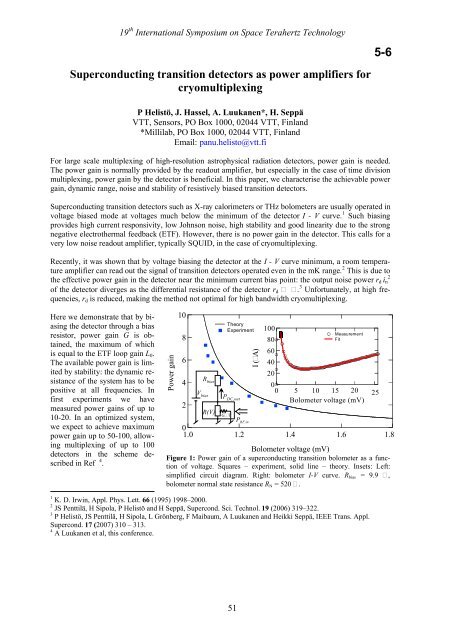Program and Abstract Book - SRON
Program and Abstract Book - SRON
Program and Abstract Book - SRON
Create successful ePaper yourself
Turn your PDF publications into a flip-book with our unique Google optimized e-Paper software.
19 th International Symposium on Space Terahertz Technology<br />
5-6<br />
Superconducting transition detectors as power amplifiers for<br />
cryomultiplexing<br />
P Helistö, J. Hassel, A. Luukanen*, H. Seppä<br />
VTT, Sensors, PO Box 1000, 02044 VTT, Finl<strong>and</strong><br />
*Millilab, PO Box 1000, 02044 VTT, Finl<strong>and</strong><br />
Email: panu.helisto@vtt.fi<br />
For large scale multiplexing of high-resolution astrophysical radiation detectors, power gain is needed.<br />
The power gain is normally provided by the readout amplifier, but especially in the case of time division<br />
multiplexing, power gain by the detector is beneficial. In this paper, we characterise the achievable power<br />
gain, dynamic range, noise <strong>and</strong> stability of resistively biased transition detectors.<br />
Superconducting transition detectors such as X-ray calorimeters or THz bolometers are usually operated in<br />
voltage biased mode at voltages much below the minimum of the detector I-Vcurve. 1 Such biasing<br />
provides high current responsivity, low Johnson noise, high stability <strong>and</strong> good linearity due to the strong<br />
negative electrothermal feedback (ETF). However, there is no power gain in the detector. This calls for a<br />
very low noise readout amplifier, typically SQUID, in the case of cryomultiplexing.<br />
Recently, it was shown that by voltage biasing the detector at the I-Vcurve minimum, a room temperature<br />
amplifier can read out the signal of transition detectors operated even in the mK range. 2 This is due to<br />
2<br />
the effective power gain in the detector near the minimum current bias point: the output noise power r d i n<br />
of the detector diverges as the differential resistance of the detector r d . 3 Unfortunately, at high frequencies,<br />
r d is reduced, making the method not optimal for high b<strong>and</strong>width cryomultiplexing.<br />
Here we demonstrate that by biasing<br />
the detector through a bias<br />
resistor, power gain G is obtained,<br />
the maximum of which<br />
is equal to the ETF loop gain L 0 .<br />
The available power gain is limited<br />
by stability: the dynamic resistance<br />
of the system has to be<br />
positive at all frequencies. In<br />
first experiments we have<br />
measured power gains of up to<br />
10-20. In an optimized system,<br />
we expect to achieve maximum<br />
power gain up to 50-100, allowing<br />
multiplexing of up to 100<br />
detectors in the scheme described<br />
in Ref 4 .<br />
gain<br />
Power<br />
10<br />
8<br />
6<br />
4<br />
2<br />
0<br />
1.0<br />
V bias<br />
R bias<br />
R(V)<br />
Theory<br />
Experiment 100<br />
P DC,out<br />
G, T<br />
P RF,in<br />
1.2<br />
I ( A )<br />
80<br />
60<br />
40<br />
20<br />
0<br />
0<br />
5 10 15 20<br />
Bolometer voltage (mV)<br />
Bolometer voltage (mV)<br />
Figure 1: Power gain of a superconducting transition bolometer as a function<br />
of voltage. Squares – experiment, solid line – theory. Insets: Left:<br />
simplified circuit diagram. Right: bolometer I-V curve. R bias = 9.9 ,<br />
bolometer normal state resistance R N =520 .<br />
1.4<br />
Measurement<br />
Fit<br />
1.6<br />
25<br />
1.8<br />
1 K. D. Irwin, Appl. Phys. Lett. 66 (1995) 1998–2000.<br />
2 JS Penttilä, H Sipola, P Helistö <strong>and</strong> H Seppä, Supercond. Sci. Technol. 19 (2006) 319–322.<br />
3 P Helistö, JS Penttilä, H Sipola, L Grönberg, F Maibaum, A Luukanen <strong>and</strong> Heikki Seppä, IEEE Trans. Appl.<br />
Supercond. 17 (2007) 310 – 313.<br />
4 A Luukanen et al, this conference.<br />
51
















